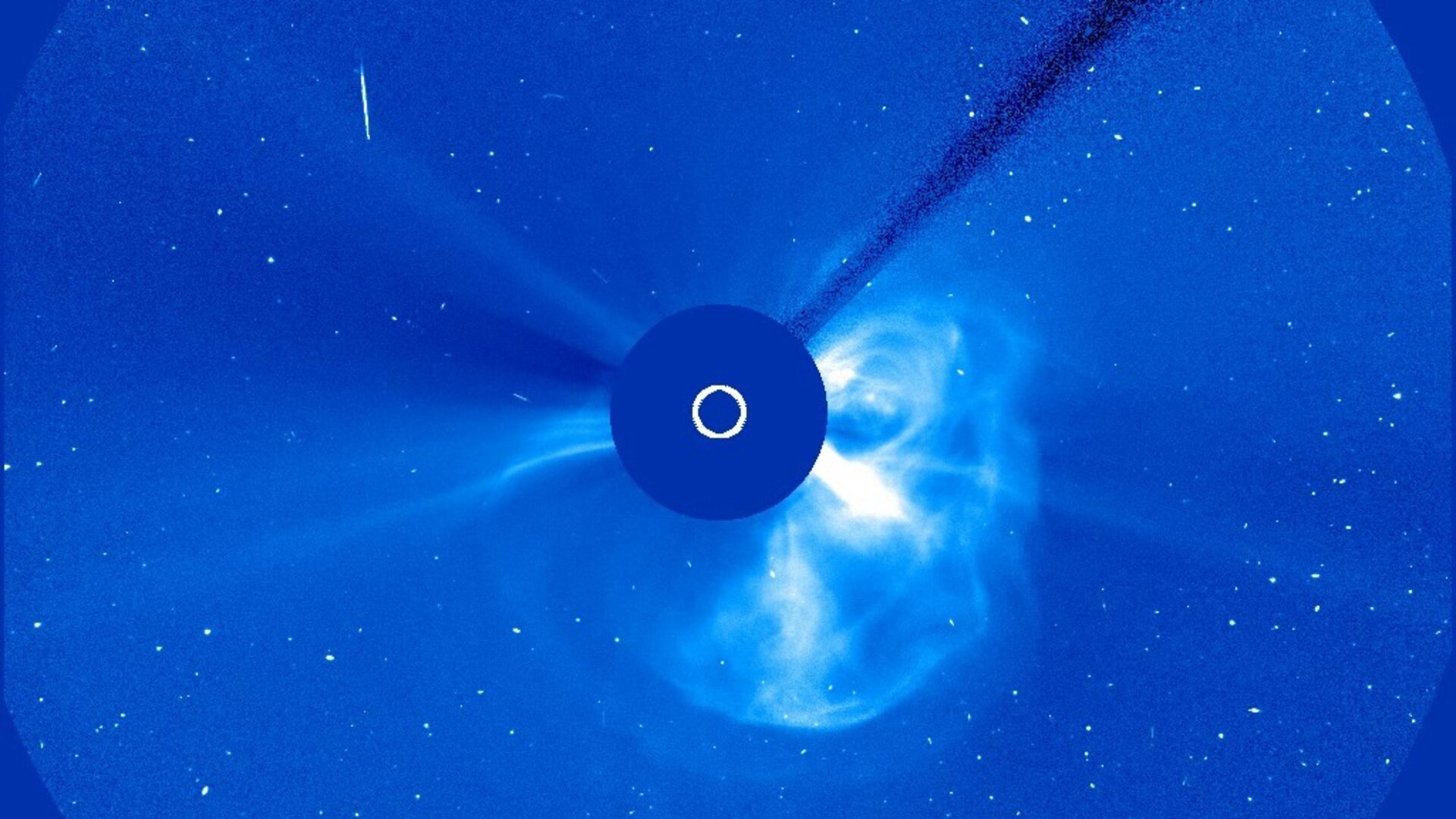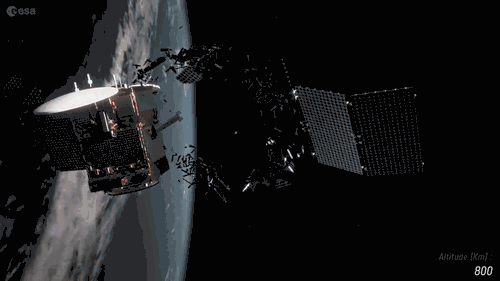The story so far
ESA’s Space Situational Awareness (SSA) programme was launched in 2009, with the aim of ensuring that Europe could independently detect, predict and assess threats from space and their potential risk to life, property and infrastructure.
Detecting hazards
As its title suggested, the SSA programme was established with the primary goal of making us more aware of the constantly evolving situation of hazards in space.
This meant developing new technology to detect and track the hazards that come along with living so close to an active star, in a Solar System filled with ancient and fast-moving space rocks and on a planet that is becoming increasingly surrounded by discarded satellites and their debris.
The programme was split into three segments reflecting these dangers, and was based at ESA’s Operations Centre in Darmstadt, Germany. This is the story so far...
Space Weather Segment


Access the video
– Watching our Sun and warning of hazardous space weather
Unpredictable and temperamental, the Sun makes life on the inner planets of the Solar System impossible due to the intense radiation combined with colossal amounts of energetic material that it blasts in every direction, creating the ever-changing conditions in space known as ‘space weather’.
Our magnetic field protects us from the solar wind — the constant stream of electrons, protons and heavier ions from the Sun — and from Coronal Mass Ejections (CMEs), the Sun’s occasional outbursts of billion-tonne clouds of solar plasma into space. The most extreme events, arrivals of fast CMEs or high-speed solar-wind streams, disturb our protective magnetic shield, creating geomagnetic storms at Earth.
These storms have the potential to cause serious problems for modern technological systems, disrupting or damaging satellites in space and the multitude of services — like navigation and telecoms — that rely on them, blacking out power grids and radio communication and creating a radiation hazard for astronauts in space, even serving potentially harmful doses of radiation to astronauts on future missions to the Moon or Mars.
While these events can’t be stopped, advance warning of an oncoming solar storm would give operators of satellites, power grids and telecommunication systems time to take protective measures.
The Space Weather Segment of the SSA programmge was set up with the goal of providing owners and operators of critical spaceborne and ground-based infrastructure timely and accurate information that will enable mitigation of the adverse impacts of space weather.
In order to achieve accurate and reliable space-weather services, constant monitoring of the Sun and the space environment from a range of vantage points is needed, together with timely dissemination of reliable data to those needing the information.
Highlights
- Establishment of the Space Weather Coordination Centre at the Space Pole, Brussels, Belgium
- Establishment of the Space Weather Service Network, which now includes dozens of European and international partner institutions, scientific establishments and ground-based or space-borne sensor systems
- The network today is the world’s most extensive serving space weather needs and provides free distribution of over 200 ‘products’ -- processed data sets -- to hundreds of customers including governments, industry and academia
- Development of five European Space Weather Expert Service Centres, focussing on solar weather, space radiation, ionospheric weather, geomagnetic conditions, and heliospheric weather
- Establishment of the Space Weather Data Centre, ESA Redu Centre, Belgium
- The mission operations of ESA’s existing Proba-2 solar observatory satellite were taken over by the SSA programme, becoming in effect the first ‘SSA mission’
- ESA together with European industry are now studying options the Lagrange mission, a future solar observation satellite that will keep watch on the Sun and provide early warning of dangerous activity
- The programme is deploying ‘piggyback’ hosted payloads, placing space-weather sensors on missions with spare capacity; the first, 'SOSMAG', went aloft on the Korean GEO-KOMPSAT-2A satellite in December 2018, and the second will ride into space on ESA’s EDRS-C satellite in 2019; more are planned in future.
As of 2019, the work of the Space Weather segment will fall under the new Space Weather Office, a fundamental part of ESA's space safety and resilience-building activities.
Near-Earth Object Segment


Access the video
– Coordinating Europe’s efforts in the global asteroid hunt
The term ‘Near-Earth object’ (NEO) basically refers to any natural object, like an asteroid, whose orbit brings it close to Earth. While impacts from large, dinosaur-threatening asteroids are extremely unlikely, smaller objects – like the one that caused the Chelyabinsk event in 2013, injuring around 1500 people and causing damage in excess of €13 million – are far more common.
As of March 2019, we knew of more than 19 700 near-Earth asteroids, over 800 of which were in the ‘risk list’.
ESA’s Near-Earth Object Segment was set up to ensure we are aware of the current and future position of Earth-crossing asteroids and comets, estimate the likelihood and consequence of possible impacts on our planet and develop methods to mitigate risks.
One of the key goals of the near-Earth object segment is to provide early warning to areas on the ground that are at risk of a Chelyabinsk-like impact - an explosive fireball in the atmosphere - hours to days before it happens.
Highlights
- Establishment of the Near-Earth Object Coordination Centre (NEOCC) in Italy
- The SSA programme took over the European asteroid database
- Discovered hundreds of new asteroids and confirmed that many others can be safely excluded from the risk list
- Location of the first Flyeye telescope was agreed, placing it upon the Monte Mufara mountain in Sicily
- Initial design completed of the Flyeye telescope, to enable full-sky scans on the lookout for space rocks
- Studied and assessed, in cooperation with international scientific and political bodies such as the UN, the best way to coordinate warnings if a potential Earth impactor is detected
- Developed future Hera mission to test asteroid deflection
- Test-bed optical telescopes have been installed at ESA’s ground station site at Cebreros, Spain, and at La Silla, Chile (in progress). These are being used to develop and test new observation software and techniques.
As of 2019, the work of the Near-Earth Office segment will fall under the new Planetary Defence Office.
Space Surveillance and Tracking segment

– Detecting, predicting and warning about the movements of in-orbit debris
Our planet is surrounded by thousands of artificial satellites, which every day bring internet connectivity, mobile phone data, GPS location services, weather updates, entertainment and more, to people around the globe.
However, there are even greater number of orbiting objects that are merely remnants of past explosions, collisions and launches. This technological trash makes the space around Earth a perilous place to reside, and without action, certain regions around Earth will be totally off-limits for future missions, satellites and technology.
ESA’s Space Surveillance and Tracking Segment was setup to detect and predict the movement of space debris in orbit around Earth, issuing warnings and guidance to spacecraft operators so they can get their out of harm’s way.
Highlights
- In 2018 alone, teams at ESOC performed 28 ‘Collision Avoidance Manoeuvres’ – moving satellites and spacecraft out of the way of space debris
- Research and development in satellite laser ranging
- Research and development in optical surveillance techniques
- Test and validation of radar detection techniques
- Two new test radars have already been contracted, built and installed by industrial partners, one located in Spain and one in France, to test, validate and develop future radar search and detection techniques, a capability not currently available in Europe under civil control.
- Development and installation of a monostatic test radar, Santorcaz, Spain
- Development and installation of a bistatic test radar, France
As of 2019, the work of the Space Surveillance and Tracking segment will fall under the Space Debris Office.
Looking ahead
The SSA programme has highlighted how ESA is in a unique position, with the cooperation and support of 22 member states, to coordinate the European response to space hazards.
The Agency is now making preparations for the future, with ambitious plans to respond to these hazards, through mitigation, prevention and protection measures. These space safety & security activities have grown out of the success of the Space Situational Awareness programme, and will use the tools developed so far to ensure that Europe can act to protect its citizens.
Find out more about ESA’s upcoming space safety & security activities.


